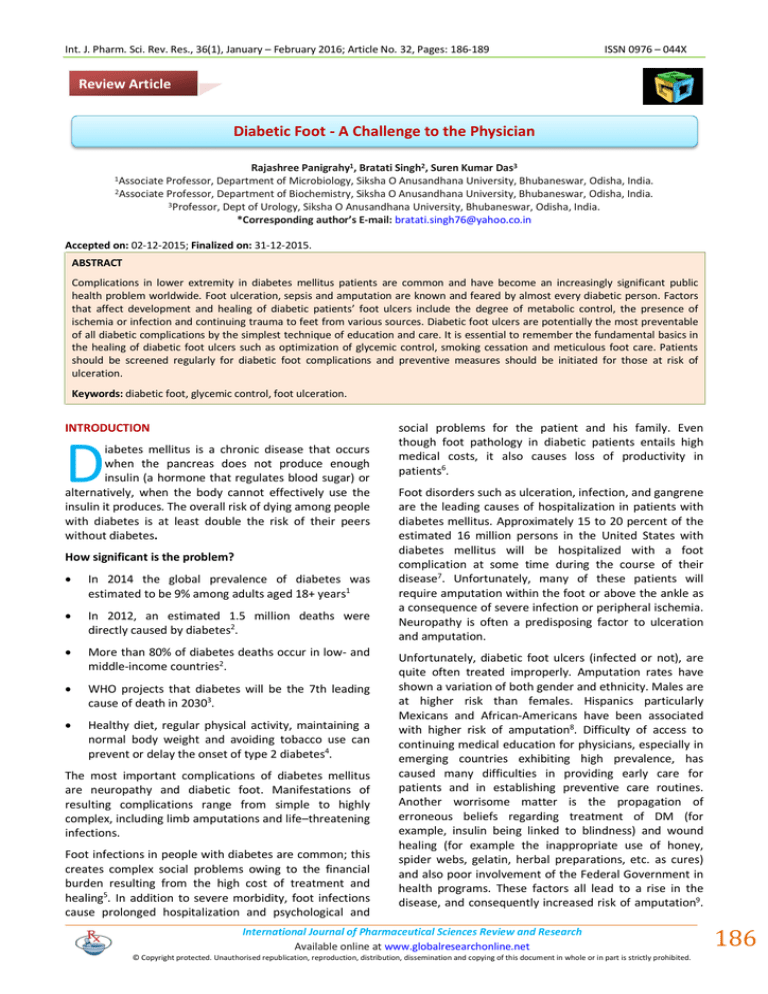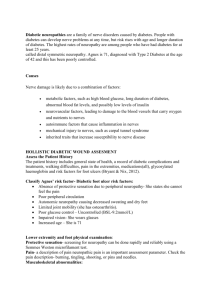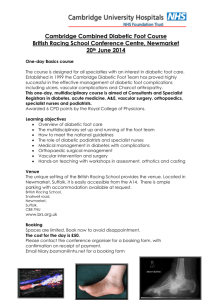Document 13310810
advertisement

Int. J. Pharm. Sci. Rev. Res., 36(1), January – February 2016; Article No. 32, Pages: 186-189 ISSN 0976 – 044X Review Article Diabetic Foot - A Challenge to the Physician Rajashree Panigrahy1, Bratati Singh2, Suren Kumar Das3 Professor, Department of Microbiology, Siksha O Anusandhana University, Bhubaneswar, Odisha, India. 2Associate Professor, Department of Biochemistry, Siksha O Anusandhana University, Bhubaneswar, Odisha, India. 3Professor, Dept of Urology, Siksha O Anusandhana University, Bhubaneswar, Odisha, India. *Corresponding author’s E-mail: bratati.singh76@yahoo.co.in 1Associate Accepted on: 02-12-2015; Finalized on: 31-12-2015. ABSTRACT Complications in lower extremity in diabetes mellitus patients are common and have become an increasingly significant public health problem worldwide. Foot ulceration, sepsis and amputation are known and feared by almost every diabetic person. Factors that affect development and healing of diabetic patients’ foot ulcers include the degree of metabolic control, the presence of ischemia or infection and continuing trauma to feet from various sources. Diabetic foot ulcers are potentially the most preventable of all diabetic complications by the simplest technique of education and care. It is essential to remember the fundamental basics in the healing of diabetic foot ulcers such as optimization of glycemic control, smoking cessation and meticulous foot care. Patients should be screened regularly for diabetic foot complications and preventive measures should be initiated for those at risk of ulceration. Keywords: diabetic foot, glycemic control, foot ulceration. INTRODUCTION D iabetes mellitus is a chronic disease that occurs when the pancreas does not produce enough insulin (a hormone that regulates blood sugar) or alternatively, when the body cannot effectively use the insulin it produces. The overall risk of dying among people with diabetes is at least double the risk of their peers without diabetes. How significant is the problem? In 2014 the global prevalence of diabetes was estimated to be 9% among adults aged 18+ years1 In 2012, an estimated 1.5 million deaths were directly caused by diabetes2. More than 80% of diabetes deaths occur in low- and middle-income countries2. WHO projects that diabetes will be the 7th leading cause of death in 20303. Healthy diet, regular physical activity, maintaining a normal body weight and avoiding tobacco use can prevent or delay the onset of type 2 diabetes4. The most important complications of diabetes mellitus are neuropathy and diabetic foot. Manifestations of resulting complications range from simple to highly complex, including limb amputations and life–threatening infections. Foot infections in people with diabetes are common; this creates complex social problems owing to the financial burden resulting from the high cost of treatment and healing5. In addition to severe morbidity, foot infections cause prolonged hospitalization and psychological and social problems for the patient and his family. Even though foot pathology in diabetic patients entails high medical costs, it also causes loss of productivity in patients6. Foot disorders such as ulceration, infection, and gangrene are the leading causes of hospitalization in patients with diabetes mellitus. Approximately 15 to 20 percent of the estimated 16 million persons in the United States with diabetes mellitus will be hospitalized with a foot complication at some time during the course of their disease7. Unfortunately, many of these patients will require amputation within the foot or above the ankle as a consequence of severe infection or peripheral ischemia. Neuropathy is often a predisposing factor to ulceration and amputation. Unfortunately, diabetic foot ulcers (infected or not), are quite often treated improperly. Amputation rates have shown a variation of both gender and ethnicity. Males are at higher risk than females. Hispanics particularly Mexicans and African-Americans have been associated with higher risk of amputation8. Difficulty of access to continuing medical education for physicians, especially in emerging countries exhibiting high prevalence, has caused many difficulties in providing early care for patients and in establishing preventive care routines. Another worrisome matter is the propagation of erroneous beliefs regarding treatment of DM (for example, insulin being linked to blindness) and wound healing (for example the inappropriate use of honey, spider webs, gelatin, herbal preparations, etc. as cures) and also poor involvement of the Federal Government in health programs. These factors all lead to a rise in the disease, and consequently increased risk of amputation9. International Journal of Pharmaceutical Sciences Review and Research Available online at www.globalresearchonline.net © Copyright protected. Unauthorised republication, reproduction, distribution, dissemination and copying of this document in whole or in part is strictly prohibited. 186 Int. J. Pharm. Sci. Rev. Res., 36(1), January – February 2016; Article No. 32, Pages: 186-189 Many scientific studies have led to the establishment of programs designed to prevent and promote awareness on diabetic foot complications. As a result, the rate of amputations dropped by nearly 50%10. The etiology of diabetic foot ulcers usually has many components. A recent multicenter study attributed 63 percent of diabetic foot ulcers to the critical triad of peripheral sensory neuropathy, trauma, and deformity. Other factors in ulceration are ischemia, callus formation, and edema. Although infection is rarely implicated in the etiology of diabetic foot ulcers, the ulcers are susceptible to infection once the wound is present. Many of the risk factors for foot ulcer are also predisposing factors for amputation, because ulcers are primary causes leading to amputation11. The afore-mentioned conditions, together with peripheral neuropathy, contribute to a lack of sensation in poorly vascularized lower extremities that are prone to the development of chronic wounds. Lack of sensation leads to exacerbation of the injury. Dry, stiff skin cracks easily and causes splits or fissures. A fissure in the protective epidermal covering (stratum corneum), can become infected, resulting in localized cellulitis or even small longitudinal ulcerations that can potentially become infected and frequently lead to the spread of infection and the ultimate loss of the lower limb, either partial or full. Poor circulation occurs in conducting vessels, consequently affecting microcirculation, which in turn affects the basement membrane, thickening and diminishing vascular reparative capacity12. The most important risk factors for the development of diabetic foot ulcers are: peripheral neuropathy (motor, sensory and autonomic), structural and anatomical deformities, environmental factors, peripheral vascular disease, a compromised immune system and poor metabolic control, in addition to social influences such as emotional, psychological and behavioral problems13. Pathophysiology of diabetic foot ISSN 0976 – 044X dysfunction; these mechanisms produce disorders in metabolism and microcirculation. EDFH= Endhotelium derived hyperpolarizing factor, NBF=nerve blood flow, NGF=nerve growth factors NVC= Nerve velocity conduction, PXG= Glutathion Peroxidase, SOD= Superoxide Dismutase5. Clinical presentation About 50% of patients with foot ulcers due to DM present clinical signs of infection. By definition, infection is characterized by the presence of purulent secretions or at least two of the classic signs of inflammation (erythema, hyperemia, edema, or swelling and pain), but these data can be masked by lack of the sensitivity in the patient due to sensory neuropathy or impaired immune response. It is also common that patients with infection are associated with poor metabolic control. Therefore, we must take into account other aspects of infected ulcers due to diabetes, including lack of granulation tissue, delayed healing or odor. Evaluating the diabetic patient who has an ulcer All diabetic foot infections require antibiotic treatment. However, not all ulcers are infected from the beginning and therefore do not require antibiotics. The main premise is that antibiotic treatment will be used to clear up infection and not for wound healing, which takes longer14. The following aspects should be taken into account to choose the right antibiotics: 1. The microbiology of the wound should be understood, starting with broad-spectrum empirical therapy for moderate and severe infections and a relatively small range for moderate infections. We can’t forget factors such as recent antibiotic use, exposure to hospital facilities and local antibiotic susceptibility. 2. The route of administration is of great importance for the success of treatment; for serious infections the recommended route is parenteral, and mild to moderate infections can start with oral or parenteral impregnation treatment for further oral treatment, adjusting to highly bio-available drugs like quinolones and the oxazolidinones. 3. The duration of antibiotic treatment should be determined according to the severity of the infection; mild infections only require 2 to 4 weeks, severe infections may require 6 to 12 weeks or more. Unfortunately in severe infections the amputation of part or the entire foot is a high probability. 4. The selection of a specific agent or combination of antibiotics is based on the considerations discussed above and the condition of each patient (renal failure, allergies, etc.), restrictions of presentation, convenience and monetary cost15. Principles of management Figure 1: Role of different mechanisms in neuropathy. The most important are oxidative stress and endothelium The first principle is to treat any infection; the second is to establish whether any associated ischaemia is International Journal of Pharmaceutical Sciences Review and Research Available online at www.globalresearchonline.net © Copyright protected. Unauthorised republication, reproduction, distribution, dissemination and copying of this document in whole or in part is strictly prohibited. 187 Int. J. Pharm. Sci. Rev. Res., 36(1), January – February 2016; Article No. 32, Pages: 186-189 amenable to revascularisation; the third is to keep forces applied to the ulcerated part to a minimum; and the fourth is to improve the condition of the wound or ulcer by wound-bed preparation, topical applications, and removal of callus. Once the wound has healed, attention can be turned to the prevention of ulcer recurrence. Eradication of infection The antibiotic regimen chosen should be based on the anticipated spectrum of infecting organisms. The combination of an aminopenicillin and a penicillinase inhibitor has the required activity, but other options include a quinolone plus either metronidazole or clindamycin. Intravenous options for soft-tissue infection include imipenem and gentamicin. Vancomycin, teicoplanin, rifampicin, or linezolid should be used for meticillin-resistant S aureus. The same broad-spectrum antibiotics are appropriate for osteomyelitis. Betalactams and quinolones are concentrated intracellularly at the site of infection, and clindamycin penetrates bones well. It has always been taught that infected bone should be removed, but a non-surgical approach might be effective. The relative benefits of parenteral versus oral antibiotics are not known, but the parenteral route is preferred if the foot is severely ischemic or in cases of systemic illness. Nor is the optimum duration of treatment known, though most clinicians opt for prolonged courses despite risks of inducing antibiotic resistance16. Prevention Primary prevention is the aim of diabetes management, but secondary prevention is the goal of good foot-ulcer care. The recurrence rate is high and ulcer healing should be followed by a well coordinated programme of secondary prevention. Sadly, this approach is beyond the capacity of health services in most countries. Surgery to correct deformities and abnormalities of posture, gait, and load-bearing (e.g, lengthening the achilles tendon) has a place in both primary and secondary prevention, but is probably underused. Structure of care Successful management of diabetic foot ulcers requires close collaboration between many different groups in primary care and in the hospital service, and this collaboration might not be easy to establish while traditional barriers between health-care professionals remain in place. Supervision is also made difficult by the frequent coincidence of both social and medical problems, when the patient may be looked after by independent teams of professional caretakers. The needs and wishes of the patient (or his or her family) in influencing management choices are critical, and informed decisions by the patient should be an essential part of the process. Patients and caretakers should be counseled by trained health-care professionals at every stage, and should have ready access to a second opinion. All specialists who treat diabetic foot need to remember ISSN 0976 – 044X this important message: “Neuropathic symptoms correlated poorly with sensory loss, and the absence of sensory loss must not be equated to no risk of foot ulcers. Therefore, the assessment of foot ulcer risk must always include a careful foot examination, with the removal of shoes and socks, regardless of the patient’s neuropathic history”17. CONCLUSION Despite progress in knowledge regarding the pathophysiology of ulcers, the mechanisms involved nowadays are not completely clear. The main mechanisms: neuropathy, deformity and trauma along with physiopathogenic information at the molecular level and knowing the structural and anatomic alterations (clawing toes, hammer toes, cavus foot, equinus foot, etc), are all important to draw up strategies for treatment and prevention. On the other side, offloading increases pressure on the foot, thus leading to alterations in environmental factors such as gait, instability and limited joint mobility. All of this suffices to explain the changes in the architecture of the foot and this, in turn, allows for drawing up prevention policies. Changes in the microcirculation of the foot in patients with diabetes remains one of the major causes of difficulty in wound healing associated with thickening of the vascular endothelium, the release of vasodilator substances and the participation of endothelial cells in angiogenesis and reparative processes of the wound. These together represent the most advanced knowledge available at the molecular level. The vasodilatation depending on the endothelium cell reduces the expression of nitric oxide synthase which further deteriorates the microenvironment of the wound. More recent mechanisms, such as the knowledge of the deterioration on the nerve cell particularly the reflex nerve-axon, coupled with changes in the polymerase activity (ADP ribose) and the increase of the formation of nitrous tyrosine give us hope for the future of healing ulcers. A better understanding of cellular changes and the interplay between formation of connective tissue, collagen tissue formation (collagen is part of the skin, bone, tendons and ligaments), the expression of growth factors and cytokines are involved in tissue repair of wounds in people with diabetes. In addition, it is proposed to take increased care in early injury or trauma and prevention of use of inadequate shoes and offload pressures to stop formation of ulcers. If ulcers do form, adequate treatment, foot care and complete rest for the foot could prevent amputation. It is clear that the spectrum of treatment of diabetic foot ulcers requires the participation of several specialists. Foot ulcers are not the responsibility of a single medical professional, they are the responsibility of a multidisciplinary team working for the care and healing of foot ulcers. On this team we can contact physicians, surgeons, orthopedic, vascular surgeons, podiatrists, neurologists, endocrinologists, orthotics, specialist nurses and all International Journal of Pharmaceutical Sciences Review and Research Available online at www.globalresearchonline.net © Copyright protected. Unauthorised republication, reproduction, distribution, dissemination and copying of this document in whole or in part is strictly prohibited. 188 Int. J. Pharm. Sci. Rev. Res., 36(1), January – February 2016; Article No. 32, Pages: 186-189 practitioners and specialists interested in the care and attention of the foot. A clear, complete and current vision of the management of ulcers in diabetic patients by detecting and treating risk factors at an early stage, directing the entire team of health professionals as one would an orchestra in which the symphony focuses on sparing the patient with diabetic foot from dire consequences. REFERENCES 1. Global status report on noncommunicable diseases 2014. Geneva, World Health Organization, 2012. 2. World Health Organization. Global Health Estimates: Deaths by Cause, Age, Sex and Country, 2000-2012. Geneva, WHO, 2014. 3. Mathers CD, Loncar D. Projections of global mortality and burden of disease from 2002 to 2030. PLoS Med, 2006, 3(11), e442. 4. Global status report on noncommunicable diseases 2010. Geneva, World Health Organization, 2011. 5. Aguilar F. Diabetic Foot; physiopathology and treatment, In: Diabetic Neuropathy, Practical aspects, treatment, diagnostic and prophylactic measures, Aguilar Rebolledo Francisco, Alfil editorial, 2009a, 335-336. 6. Ramsey SD, & Newton K, & Blough D. Incidence, outcomes and cost of foot ulcers in patients with diabetes. Diabetes Care. 22(3); 1999, 382-7. 7. Reiber GE, Boyko EJ, Smith DG. Lower extremity foot ulcers and amputation in diabetes. In: Harris MI, Cowie CC, Stern MP eds. Diabetes in America. 2nd ed. Bethesda, MD: National Institutes of Health, National Institute of Diabetes and Digestive and Kidney Diseases; 1995, 409–428. NIH publication 95-1468. ISSN 0976 – 044X 8. Velasco Mondragon HE, William Charlton R, Peart T. Diabetes Risk Assessment in Mexicans and Mexican Americans, Diabetes Care. 33(10), 2010, 2260–2265. 9. Tentolouris N: Introduction to diabetic Foot, In: Atlas of the diabetic Foot, Katsilambros, Wiley-Blackwell editorial; 2010, 1-10. 10. Li R, Zhang P, Barker LE, Chowdhury FM, Zhang X. Costeffectiveness of interventions to prevent and control diabetes mellitus: a systematic review. Diabetes Care. 33, 2010, 1872–1894. 11. Boyko EJ, Ahroni JH, Stensel V, Forsberg RC, Davignon DR, Smith DG. A prospective study of risk factors for diabetic foot ulcer: the Seattle Diabetic Foot Study. Diabetes Care. 22, 1999, 1036-42. 12. Tanenberg RJ, Donofrio PD. Neuropathic problems of the lower extremities in diabetic patients. In: Bowker JH, Pfeifer MA, editors. Levin and O’Neal’s the diabetic foot, 7th ed. St. Louis: Mosby; 2008. 13. Lyons TE. Management of diabetic foot complications, In: Diabetic Neuropathy, Clinical management. Humana Press editorial 2008a, 480-82. 14. Lipsky BA. Evidence-based antibiotic therapy of diabetic foot infections. FEMS Immunol Med Microbiol. 26, 1999, 267–276. 15. Lipsky BA, Berendt AR. Infection of the Foot in persons with diabetes: Epidemiology, Pathophysiology, Microbiology, Clinical presentation, and Approach to therapy. The foot in diabetes, 2006a, 187-197. 16. Akbari CM, Pomposelli FB Jr, Gibbons GW. Lower extremity revascularisation in diabetes: late observations. Arch Surg. 135(4), 2000, 452–56. 17. Boulton AJM, & Gries FS, & Jervell J. Guidelines for the diagnosis and outpatient management of diabetic peripheral Neuropathy. Diabetic Medicine. 15(6), 1998, 508-14. Source of Support: Nil, Conflict of Interest: None. International Journal of Pharmaceutical Sciences Review and Research Available online at www.globalresearchonline.net © Copyright protected. Unauthorised republication, reproduction, distribution, dissemination and copying of this document in whole or in part is strictly prohibited. 189





